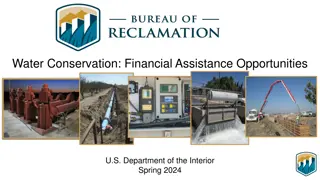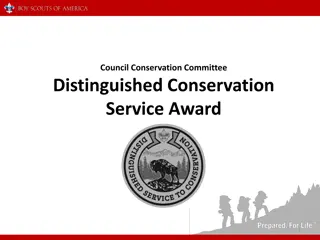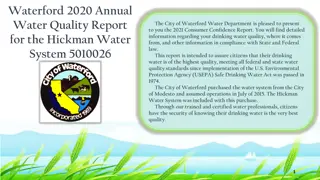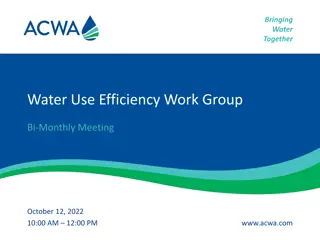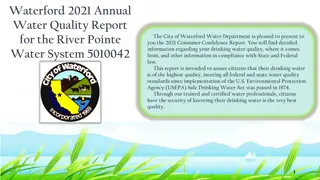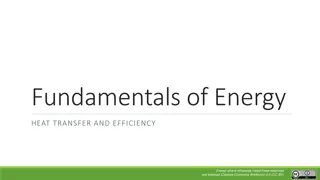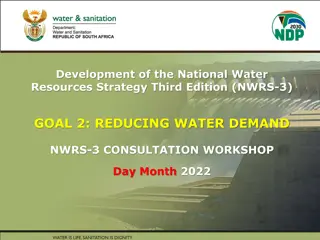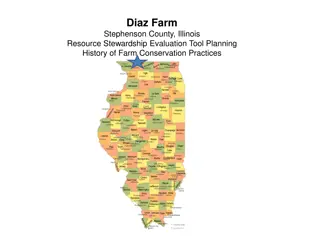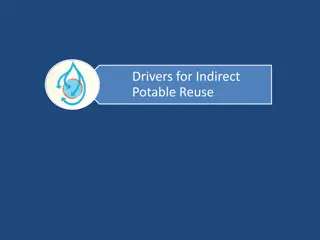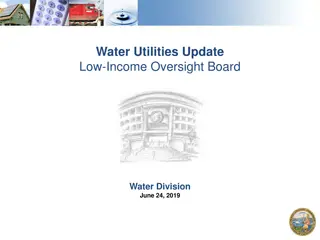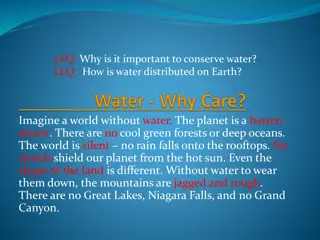Water Conservation Strategies at Sardar Patel Institute of Technology
Explore the comprehensive water conservation initiatives undertaken by the students of Sardar Patel Institute of Technology. Learn about the importance of water conservation, typical household water usage, and practical tips to reduce water consumption. Discover ways to conserve water through methods like rainwater harvesting and bathroom optimization, all while understanding the significance of employee participation in sustainable practices.
Download Presentation

Please find below an Image/Link to download the presentation.
The content on the website is provided AS IS for your information and personal use only. It may not be sold, licensed, or shared on other websites without obtaining consent from the author.If you encounter any issues during the download, it is possible that the publisher has removed the file from their server.
You are allowed to download the files provided on this website for personal or commercial use, subject to the condition that they are used lawfully. All files are the property of their respective owners.
The content on the website is provided AS IS for your information and personal use only. It may not be sold, licensed, or shared on other websites without obtaining consent from the author.
E N D
Presentation Transcript
SARDAR PATEL INSTITUTE of TECHNOLOGY
Water Conservation: The Facts and What you Can do About it. BY:- 1st SEM AUTOMOBILE
Prepared by:- Patel Jaimin [130680102026] Jani Chirag [130680102012] Patel Mit [130680102031] Patel Rhutul [1306801035] Joshi Arpana [130680102013] Ghodasara Mayank[130680102009] Guided by:- Khushbu A. Patel
GOALS Understand the Need for Water Conservation. Understand the Need for Monitoring, Submetering, and Leak Detection. Be Familiar With How Water Pressure Relates to Water Conservation. Understand the Principles of Water Recycling and Water Reuse. Be Familiar With Cooling Water Conservation. Be Familiar With Industrial Water Conservation Measures. Understand Bathroom Water Conservation Measures. Understand the Basic Principles of Xeriscape Landscaping. Understand the Importance of Water Conservation Education and Employee Participation.
Water Facts Bathroom claims nearly 75% of water use In 1990, the average person used 183 gallons of water per day. The water use is about 50% higher in the west than the east.
Shave and a haircut a bit more than two bits Turn off the water while shaving. Fill the bottom of the sink with a few inches of water to rinse your razor. Saves five gallons each day.
Rainwater Harvesting for Consumption Cost less than $1500 to build Softer Water: 5mg/gal of dissolved minerals as compared to 500 in city water. Cut water use by 95% Many use similar system for laundry and toilets.
Sawdust Toilet When used, add layer of sawdust to absorb odors. When full, empty into compost pile Some save urine separately. Can be diluted and used on plants for its nitrogen richness.
Tips from the Errsons Laundry: Use cold water Buy front loader machine Toilets: Use water saver version Better yet use compost toilet Use Rain barrels for garden water Dishwashing: Wash all dishes at once Then rinse all at once Bathing: Catch the water while the shower is warming up to water plants Turn water off while you are soaping up
Another Somewhat Extreme Idea
Waste Water Wetlands The system will function in the dormant as well as the summer season. The oxidizing purification occurs in the root activity not the nutrient removal 1 sq. ft for each gallon of daily flow. Needs: A 2 cell septic tank (removes sludge) Then a wetland constructed of 12-18 inches of gravel with native plants for the water to slowly pass through
Toilet Tidbits A family of 4 uses 881 gallons of water per week just to flush their toilet. If everyone in the US flushed one less time a day, we could save enough water to make a square mile lake that is four feet deep everyday.
Toilet Toilets made before 1993, use between 3.5 and 8 gallons per flush. Improved toilets can save a family between 14-17 thousand gallons of water per year. Newer toilets use less than 1.6 gpf. Some cities and utility companies offer incentives ranging from $25-100 or free toilet replacement. This becomes a water use difference of 9.7 gallons per day
Saving water Add bricks or two liter bottles filled with water to your tank to reduce gpf. Add food coloring to the tank, wait 30 mins. If the bowl is colored then you have a tank leak. Running water while shaving or brushing teeth, wastes more water than what one person needs for an entire week.
Shower improvements Take shorter showers Replace shower head with water savers that use 2.5 gpm or less Do not take baths. The typical bath uses over 50 gallons of water. Consider collecting excess water for use on house plants.
Kitchen Facts Typical dishwasher uses between 8 and 15 gallons per load. High efficiency washer use around 6. The Dishwasher is about 1.4% of typical water use. Faucets represent 15.7% of the typical water use. One drip per second from a faucet will waste 2,700 gallons per year
Kitchen Improvements Install low-flow faucet aerators. Only run dishwasher when full. New dishwashers are powerful. Don t pre-wash dishes. Collect excess sink water for watering plants
Kitchen (Continued) A garbage disposal wastes lots of water. Compost instead This will also reduce solid waste in waterlines by 50% or more. Do not leave running while washing dishes.
Laundry Replace old washer with water saver model. New models use 23 gallons as compared to the 41 of older machines. The washing machine accounts for 21.7% of typical water use. Only wash full loads. Pretreat stains to avoid rewashing
What is Grey Water and Dual Plumbing? Grey water is domestic wastewater from sinks, tubs, and clothing washers that is used for lawn care Dual plumbing is a process of recycling water by having to separate drainage lines to the city utility. St. Petersburg, Fl currently is using this process.
Grey water system or Dual Plumbing Must monitor plants for over fertilization and watering. Must be careful about ingredients in laundry soaps and cleaners, some can harm your plants. A family of four can create 30-40 thousand gallons of water, if system is used to full potential. Not legal in some cities and states. This stifles the ability to market and sell this technology. Will keep your plants and lawn thriving in drought conditions. Provides lots of organic materials for the plants as well.
The Car Wash A 15 min. car wash uses 100 gallons of water. Use a bucket of water and rags instead Go to a commercial car wash that reuses their water.
The Family Pool Keep water in pool. Ways to Save: A pool cover Repair any leaks An inch a day leak in a 15 X 30ft pool wastes 102,000 gallons. Turn heat down to slow evaporation. Maintain pool to avoid water waste in refilling it.
Xeriscape: History The purpose of Xeriscape was to popularize landscape water conservation and to educate people about the importance of water to humans and other life forms.
Benefits of Xeriscape Reduces water use Reduces fertilizer use Reduces pesticide use Lower maintenance costs Reduces runoff Preserves Topsoil Drought Tolerant Lower maintenance needs
Using your water meter to conserve Leaks can account for more than 10% of a typical families water bill. On a straight reading meter, read it just like a car odometer. A round reading dial : Start with the 100,000 ft dial and work around to the 1 ft dial. If between numbers round down.




